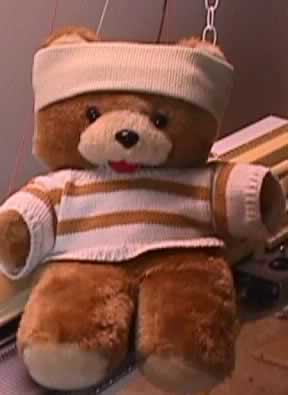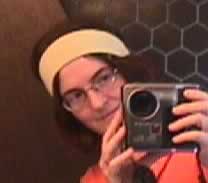To create the head band, type in your head circumference and the head
band width. The head band circumference will be 85% your head circumference.
These makes it nice and snug. My head band is 2.5 inches wide; and
fits my head. You can select your own width. By the way, if you use
cm, just enter everything in cm. Afterwards ignore the fact that
the page says inches. Also, don't enter some things in inches and other
things in cm!
Navigate my site!
HOME
Yarn to buy yarn from
The
Knitting Fiend!
Email Lucia
Interknits Machine Knitting
Club.
Support my site
|
This head band was the first project I knit with my Brother
910 knitting machine. Hubby is on vacation, so I put it on Teddy and took
his picture. He's sitting on the knitting machine! If you want
to see this head band on me, scroll down to the bottom of this page.

Strangely enough, my first hand knit project was a similar headband.
We had just moved to Buffalo, NY from San Salvador, El Salvador. It was
January. My ears were cold. I was six years old. Mom taught my older
sister and me to knit. Meanwhile, she knit headbands for the two
younger ones. I no longer have that head band!
I guess Mom designed this head band. I'm sure I didn't do the calculations
when I was 6 years old! And guess what? Your six year old doesn't have
to calculate them either! Keep scrolling and use this page to calculate
the whole thing.
When making this headband, I recommend using wool or high bulk acrylic.
My head band is made from Brown Sheep Nature Spun fingering weight which
is left over from making my turtleneck sweater.
This is a good beginner project. However, directions are written as
though you already know how to knit. If you don't know how, you will need
to consult a knitting techniques book. I'm cheap, so I advise you go to
the library and check one out. If you machine knit, read the manual.
When you find your reference, read about the following techniques:
Casting on. You will do this once. Pick the easiest technique you find.
Selecting a stitch pattern. Beginners should pick stockinet, reverse stockinet
or garter stitch. Mine is made in reverse stockinet. The one I made when
I was six was in garter stitch. Believe it or not, these were so
popular with my classmates, Mom made 12 of these for my friends. She knit
those in stripes.
Grafting live stitches. This is also known as "Kitchener Stitch". Click
here for a tutorial.
Making a gauge swatch and determine your stitch and row gauge. Click
here for information.
I hope you have fun making the head band. Good luck,
Lucia |
This beginner project teaches lots of things other than knitting techniques.
Do you realize that you:

 That's
me. As you an see, the headband coverse my ears. It fits nice
and snugly. It will be very warm because it's a double thickness.
That's
me. As you an see, the headband coverse my ears. It fits nice
and snugly. It will be very warm because it's a double thickness.